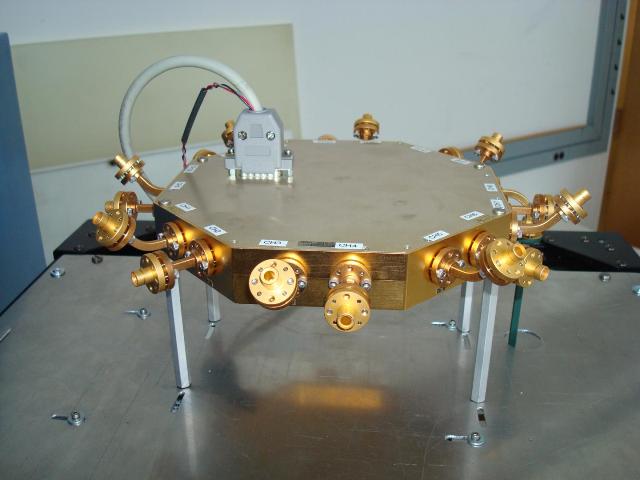Feb 23 2015
Smartphones and tablets are everywhere, which is great for communications but a growing burden on wireless channels. Forecasted huge increases in mobile data traffic call for exponentially more channel capacity. Boosting bandwidth and capacity could speed downloads, improve service quality, and enable new applications like the Internet of Things connecting a multitude of devices.
 NIST researchers developed this directional 16-antenna array to support modeling of wireless communications channels at 83 gigahertz. Credit: NIST
NIST researchers developed this directional 16-antenna array to support modeling of wireless communications channels at 83 gigahertz. Credit: NIST
To help solve the wireless crowding conundrum and support the next generation of mobile technology--5G cellular--researchers at the National Institute of Standards and Technology (NIST) are developing measurement tools for channels that are new for mobile communications and that could offer more than 1,000 times the bandwidth of today's cell phone systems.
Like pioneers who found land by going west, telecom researchers can find open spectrum by going up--to higher frequencies. Mobile devices such as cell phones, consumer WiFi devices and public safety radios mostly operate below 3 gigahertz (GHz) (see infographic). But some devices are starting to use fast silicon-germanium radio chips operating at millimeter (mm) wavelengths above 10 GHz. Researchers at NIST and elsewhere are eyeing channels up to 100 GHz and even beyond.
The metrology infrastructure for telecommunications at these frequencies is incomplete. NIST's challenge is to develop tools and test methods that are far more precise than today's versions to optimize device performance. Because high-speed digital circuits can easily distort mm wave signals, even tiny errors can result in erroneous bits of information. In addition, mm waves don't travel around corners as well as lower frequency waves, so channel models will be complex.
Possible solutions include development of complex antenna arrays that may provide novel capabilities such as beam steering--the capability to transmit in many different directions to point the beam directly at the receiving device, and even track mobile devices. This would strengthen signals and cause less interference to neighboring devices.
"We want to provide U.S. industry with the precision measurement methods needed to develop innovative millimeter-wave wireless technologies and associated standards," NIST project coordinator Kate Remley says. "This work can advance the state of the art in telecommunications and help meet the expected increases in demand for wireless capacity."
So far, Remley and her colleagues have developed a calibrated, modulated signal source to test mm wave instruments such as receivers* and "channel sounders" to support modeling of mm wave communications channels in indoor and outdoor environments. Other NIST researchers have demonstrated a new probe for making the first calibrated measurements of electric fields above 100 GHz** and a new facility for characterizing antennas operating above 100 GHz.***
The new calibrated signal source, demonstrated at 44 GHz and 94 GHz, enables measurements of modulated signals to be traced to fundamental physical quantities. The source is based on commercial parts so that companies and other users can easily put together their own systems. The mobile channel sounder, demonstrated at 83 GHz so far, provides calibrated received signal strength and additional data for analysis of signal scattering and reflections, to help researchers develop network protocols that account for distortions.
As part of the same project, NIST researchers are also developing a millimeter-wave instrument to measure the nonlinear characteristics of the transistors and amplifiers that will be used in mm wave receivers, transmitters and other devices.
All of this research is being done in NIST's new Communications Technology Laboratory. The signal source was funded in part by the Defense Advanced Research Projects Agency.